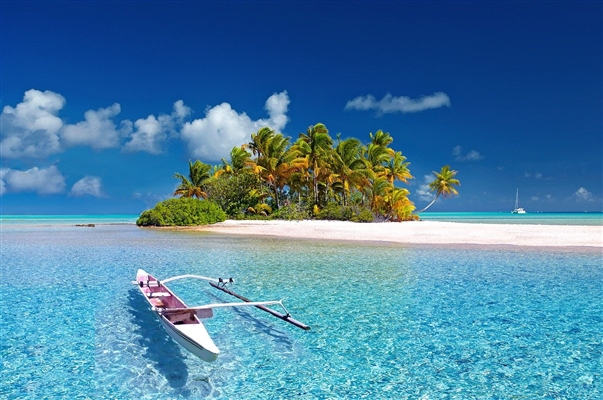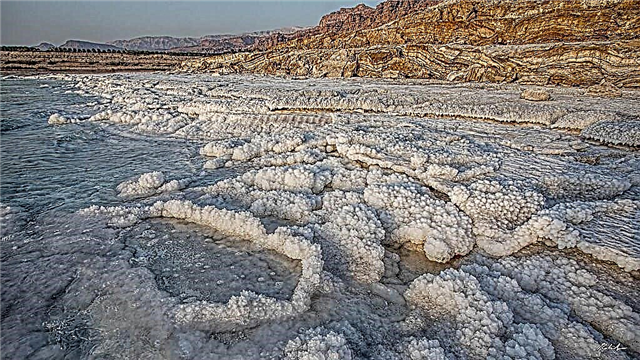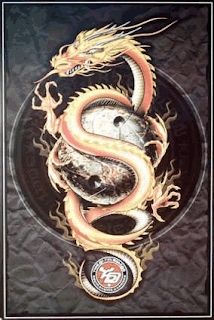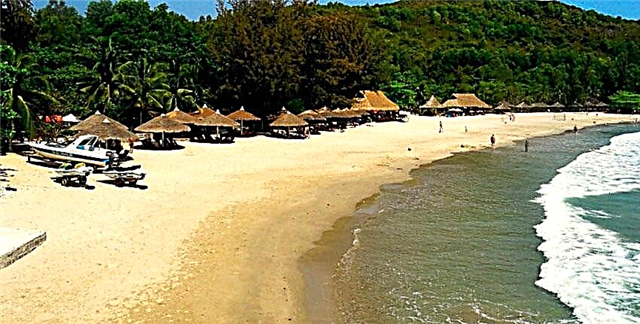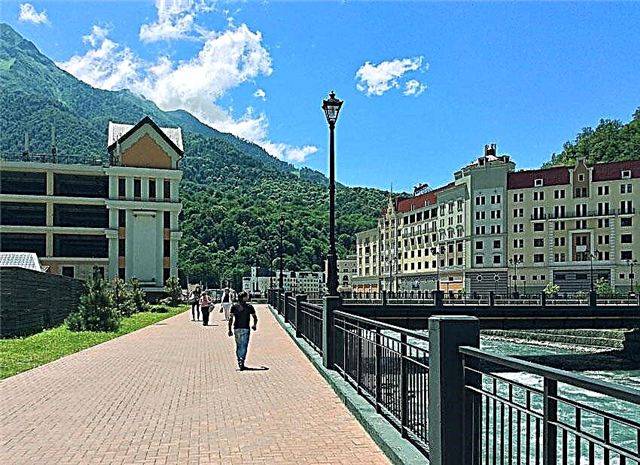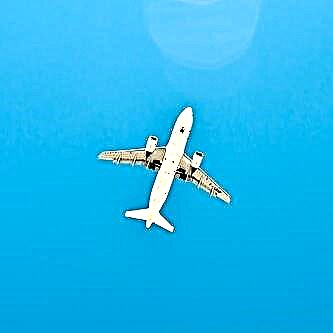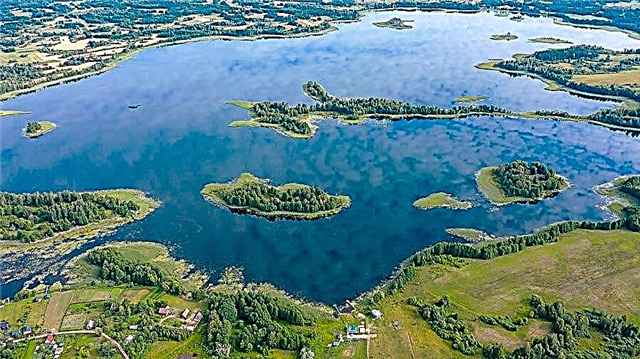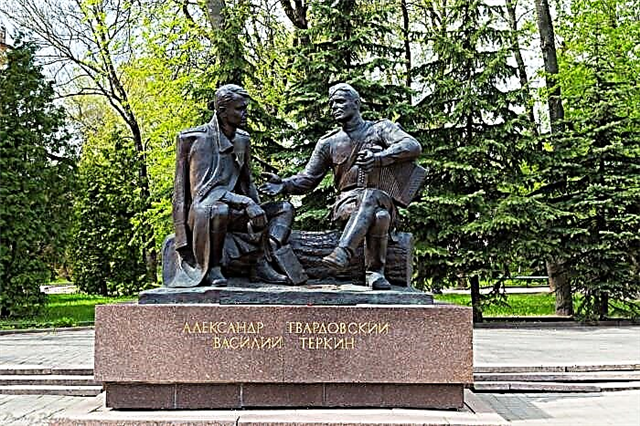Smolensk Region is one of the western border areas. In the 17th century, Smolensk had to lose many of its citizens in order to remain part of Russia. In honor of this event, a unique monument of its kind was erected on Valutina Gora. Another landmark object is the Eternal Flame. It has an analogue only in Moscow at the Tomb of the Unknown Soldier.
Among the unique monuments of Smolensk is the sculptural composition depicting the meeting of the literary character Vasily Tyorkin and its author Alexander Tvardovsky. There are no other such monuments in Russia. The city is not alien to the desire to decorate the streets with modern atr-objects. An example of such a sight is the "Equilibrium" monument.
Historical and modern monuments of Smolensk
List of the most popular monuments of the city.
"Eternal flame"
The central object of the Square in Memory of Heroes. There was a memorial burial at this place even before the opening of the monument in 1968. A bowl in the shape of a bronze star was placed on a granite pedestal. The Smolensk Eternal Flame was lit from a torch brought from Moscow from the Tomb of the Unknown Soldier. These two memorials have a number of similarities, and differ from all other similar sights in the country.

"Grateful Russia - to the Heroes of 1812"
The colorful monument is full of symbolism. It is a neat and high stone block, to the top of which an enemy warrior climbs. There, a couple of eagles are already waiting for the hero, protecting their nest. The monument reflects the inaccessibility of Russia and the ability of the people to defend their homeland, no matter what. Although the monument is a dedication to the heroes of the Patriotic War of 1812, it fits any conflict in meaning and appearance.

Monument to Alexander Tvardovsky and Vasily Terkin
In one sight of Smolensk, the character of a famous work and the author who created it converged. They sit on a log and have a lively conversation. This is the only monument of its kind in Russia. An unusual sculptural group appeared on the central square of the city in 1995. Its author is Albert Sergeev. The composition is cast in bronze. The height of the monument together with the pedestal is about 5 meters.

Monument to Fyodor Kon
The creator of the Smolensk fortress wall was immortalized in 1991. A monument to him was erected at the first of the restored towers - Gromova. There is a park and Lenin square nearby. The architect was portrayed during the design work. Fyodor Kon is thoughtful and holds the tools necessary for work in his hands. The authorities have an idea to replace the pedestal of the monument, as it stands out from the general range.

Memorial sign in honor of the liberation of the Smolensk region from the Nazi invaders
Installed not far from the Thunder Tower more than half a century ago. The wall with commemorative inscriptions is made of red granite, with soldiers fighting in the foreground. Smolensk is a hero city. More than half a million people, one way or another, suffered on this land from the fascist invaders. The feat of the soldiers-liberators is not forgotten: several times a year, memorial events are held at the monument.

Bust of A.S. Pushkin
It is located in one of the most picturesque places of the city, which is called "Pushkin's corner". The square was laid out shortly before the installation of the monument in 1976. The bust of the writer is made of bronze and placed on a granite pedestal. The author of the project is Ekaterina Belashova. Her Pushkin is pensive, rests his head with his left hand and looks down. The monument is a gift to the Smolensk Central Park from the Ministry of Culture.

"To the defenders of Smolensk on August 4-5, 1812"
The monument was placed on the main alley of the Lopatinsky Garden. The project belongs to Antonio Adamani and dates back to 1841. The monument was cast in St. Petersburg from cast iron. The height is about 26 meters. The lower part shows the battle plan, as well as the historical background. On one side there is a copy of the icon of the Smolensk Mother of God Hodegetria. In 1873, two French cannons were installed near the monument.

"Scorched Flower"
The monument is dedicated to children - prisoners of Nazi camps. The sculptor Alexander Parfyonov turned out to be heartbreaking: the flower bud is made up of children's silhouettes. They are combined to form a ball, which evokes a feeling of grief. On the leaves of such a sad flower, the author engraved the names of concentration camps. The grand opening of the monument took place in 2005 in the Park of Pioneers near the fortress wall.

"Mound of Immortality"
The opening of the memorial complex took place in 1970. The author of the idea was the architect Daniil Kovalenko. The mound is a truncated pentahedral pyramid. At its top is a stele in the form of an unfolded book. At the foot - the Eternal Flame. In addition, the monument is supplemented with a bas-relief depicting military and civilians, as well as commemorative inscriptions urging not to forget the heroes' feat.

"Grieving mother"
The composition is located in the Readovsky Park, named after the Smolensk noble family. The erection of the monument and the wall in its background dates from 1970. The abstract image on the wall of the moment of the execution of civilians is directly related to this place. During the war, there was a moat where the bodies of the dead were dumped. The figure of a grieving woman is a sign of sadness and remembrance of all the victims.

Plane-monument Tu-16
Since 1983 it has been located on Bagration Street. It was in Smolensk that the 12th separate aviation regiment was formed - the nucleus of the country's future long-range aviation. There were difficulties with the installation of the monument, since the local airfield was not adapted to receive the Tu-16 for the subsequent placement of a military vehicle on a pedestal as a monument. The aircraft was ferried according to a special plan by the extra-class pilots.

Deer sculpture
In 1909, while hunting, Wilhelm II killed a red deer. He was impressed by this animal and ordered to install his statue in his castle. The sculptor Friese completed the order and until 1944 the deer was in East Prussia. He later disappeared and was discovered by Soviet soldiers at Goering's dacha. They transported the monument to Smolensk, where they installed the deer in a small park.

"Equilibrium"
A monument to a unicycle appeared on the alley of Blonie Square in 2016. The art object is small in size, laconic and modest. Many tourists undeservedly bypass the mini-bike with their attention. Designer Alexander Sorokin put a lot of meaning into the project. The author named the monument "Equilibrium" to emphasize the need to maintain a balance between mental and physical states.

Monument to M.I.Kutuzov
Work on the creation of the monument lasted from the late 40s to 1954, when the monument was erected on Cathedral Hill. The sculpture is cast in bronze, and the pedestal is made of pink granite. The face of the commander is especially detailed. In creating the image, the authors of the project relied on paintings that were drawn from life by artists of the past. Also, some details were taken from the novel War and Peace.

Monument to the soldiers, defenders and liberators of Smolensk
Location - Victory Square. The monument is dedicated to three wars at once: the Russian-Polish, the Patriotic of 1812 and the Great Patriotic. In accordance with this, figures of soldiers dressed in uniforms from different periods of history are installed on a high pedestal around a gray obelisk. Bronze wreaths were laid at the base - a symbol of the eternal recognition of the townspeople to their defenders and liberators.

Monument to M. Glinka
The installation site was chosen near the building of the Philharmonic. Mikhail Glinka was born in the Smolensk province, although he did not live here at a conscious age. The sculpture of the composer is 2.5 meters high. He is depicted in full growth with a conductor's baton in his hand.The opening of the monument was timed to coincide with Glinka's birthday in 1885. The ceremony was attended by his equally eminent colleagues, including Pyotr Tchaikovsky.

Monument to V. Lenin
The work of the sculptor Lev Kerbel and the architect Boris Tkhor is not serial. It has no analogues in other cities. The leader of the world proletariat is dressed in a developing cloak, determination is expressed in his posture. Lenin has been standing on the square of the same name since 1967. The pedestal is a block of stone with deliberately uneven ridges. The total height of the monument is 9 meters, and the sculpture itself is 6.5 meters.

Monument to Prince Vladimir
It has been located on one of the sites on the Dnieper embankment since 2015. Prince Vladimir presses the cross to his chest and points to the river with his right hand. So he reminds: it was in its waters that the first rites of baptism took place in Russia. The height of the sculpture is about 4 meters. The opening ceremony was attended by the patriarch who consecrated the monument. The project was developed under the guidance of local sculptor Valery Gerashchenko.

Monument to soldiers-border guards
Installed at the Nikolsky gate of the fortress wall in 2018. The monument is part of the memorial complex "In memory of the Smolyans who died in the line of duty." The bronze border guard is dressed in the uniform of the Soviet years. A dog sits next to him, and a border post behind him. It bears the coat of arms of the USSR and the number of the Smolensk region - 67. The author of the project is sculptor Tatyana Nevesyolaya.

Memorial to soldiers-railroad workers
Opened in the Zadneprovsky region near the railroad tracks. Work on the memorial lasted from 1959 to 1983. The monument itself is an allusion to the rails - two parallel blocks with a star in a niche between them. During the Great Patriotic War, railway workers not only fought on the fields of war, but also ensured the operational transfer of troops from one area to another. Sometimes they worked under enemy fire without any cover.

Monument to the soldiers of the Smolensk war 1632-1634
The only monument in Smolensk dedicated to this military conflict, which made it possible to leave the city as part of Russia. It can be found on Valutina Gora. The location at a height makes the monument also a kind of observation deck, from where breathtaking views open up. At night, the landmark is illuminated with a spotlight. The author of the project is local sculptor Valery Skalka.

Monument to M.O. Mikeshin
It has been located near the building of the Russian Antiquity Museum since 1985. The opening was timed to coincide with the 150th anniversary of Mikhail Mikeshin, a sculptor and painter born in the Smolensk province. One of his most famous works is the Millennium of Russia monument in Novgorod. Igor Voskresensky and Alexander Rukavishnikov portrayed a colleague in the shop just at the time of work on this monument.

"To the soldiers of law and order who died in the line of duty"
The grand opening took place in 2014. The location of the monument is the site near the building of the Cultural Center of the Ministry of Internal Affairs. Here in the past there was a police school. The tablets contain more than 300 names of law enforcement officers who died in the line of duty. About a thousand more are inscribed in the Book of Memory. The memorial consists of the Eternal Flame, a sculptural composition and a wall with banners and a coat of arms.

Monument to A.G. Lopatin
It has been decorating the central entrance of the Lopatinsky Garden park since 2015. Alexander Lopatin is the governor who ruled the Smolensk lands in the 19th century. Under him, the province developed rapidly: educational institutions were opened, indicators in industry increased, and new public services were created. The sculptor Pyotr Fishman relied heavily on the famous photograph of the official to achieve a portrait resemblance. The height of the monument is about 3 meters.

Monument to Abraham Smolensky
It has been located in front of the Avraamiev Spaso-Preobrazhensky Monastery since 2014. Height - about 2 meters, weight - over 300 kg. The work of the sculptor Valery Grashchenko is dedicated to good deeds, sacrifice and holiness of the native of Smolensk Abraham. He was born here, was accepted as a monk and even painted two icons. The figure of the reverend elder was cast from bronze at the expense of parishioners. Abraham is depicted at the time of prayer.

Bust of Yu.A. Gagarin
It has been located on the avenue named after the first cosmonaut since 1974. The pedestal is made of bricks, faced with marble slabs and has a height of 2 meters. The bronze head of Gagarin, donated to the city by the sculptor Lev Kerbel, was hoisted on it. A small cozy square is set up around. In the Smolensk region there are several more objects renamed in memory of Gagarin, including one of the districts.

Monument to M.V. Isakovsky
The unofficial name is “a monument to my husband”. The reason for the irony is the look of the composition. Local sculptor Albert Sergeev depicted the poet leaning on a pine tree. Its branches over the head of Mikhail Isakovsky are more like horns - a symbol of adultery. The monument was erected in 2000, timed to coincide with the 100th anniversary of the songwriter. Isakovsky was born in the Smolensk region, so it was here that he was immortalized.

Monument to N. Krylenko
Installed at the intersection of Kommunisticheskaya and Marshal Zhukov streets in 1985. Nikolai Krylenko took part in the revolution, held high posts in the army, and then in the civil service. As a prosecutor, he participated in fabricated political cases. Although he was the ideologue of the "Great Terror", and he himself fell under his millstones - he was shot as a traitor. In 1955, Krylenko was rehabilitated.

Obelisk "Bayonet"
Created to perpetuate the feat of the 16th Army, which defended the city in the first months of the Great Patriotic War. Installed in the Zadneprovsky district near the railway station in 1969. The height is about 19 meters. The obelisk is made of steel in the shape of a rifle bayonet. Nearby is an extended wall with a bas-relief. It depicts Soviet soldiers going into battle. There is also an inscription: "Glory to Russian weapons."

Monument to the Sofia Regiment
Located near the Spartak stadium. The opening took place in 1912 - to the 100th anniversary of the military unit. The regiment was formed just before the war with Napoleon. At the same time, the first combat experience was obtained - the defense of Smolensk. The dead were buried right at the Royal Bastion, so the monument was subsequently erected at this very place. In Soviet times, some of the decoration details of the monument were destroyed.


